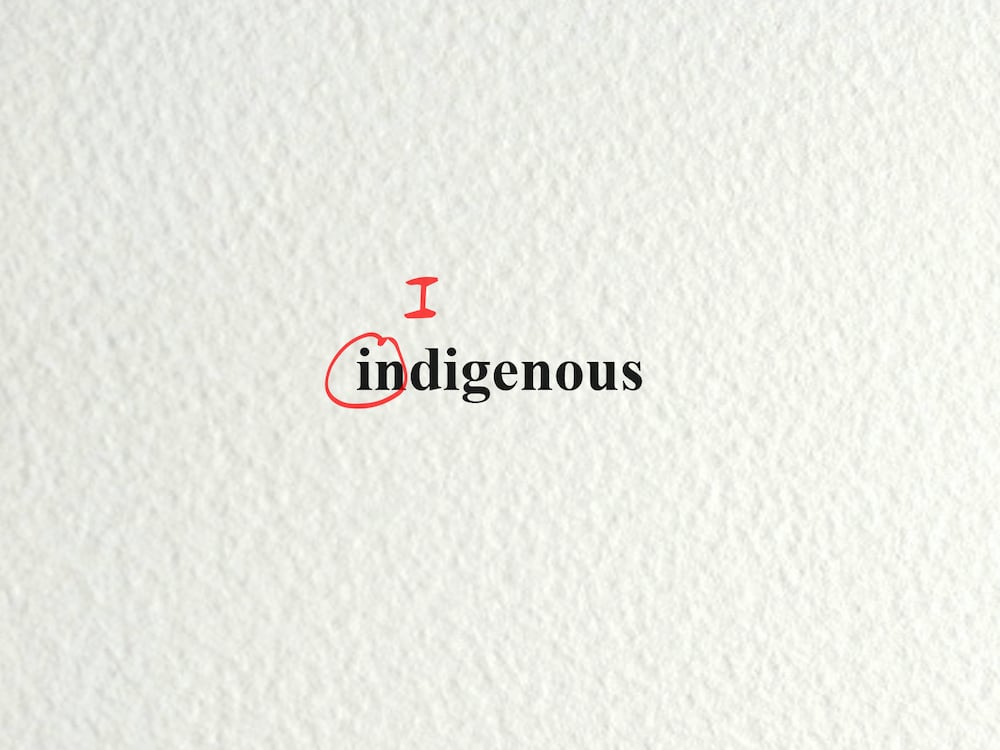At The Tyee, I’m the last person to read the stories before you do.
They come to me after they’ve been prepped by an editor: headline, check; author bio, check; story art, check. I do a last run-through to catch lingering typos and grammatical errors, and then check for a consistent style: one that aspires to be watertight about when to capitalize, abbreviate and italicize.
There are other people doing this job at The Tyee, too. But that means someone needs to be in charge of uniformity, and so a few years ago I became the head of the Tyee Style Guide, to drive consensus and establish consistency.
This can mean sending out periodic emails to remind editors and reporters about adhering to the Canada-wide journalists’ reference manual, the Canadian Press Stylebook.
But sometimes CP doesn’t make a call on something that seems relevant, and so we do.
For one: we decided to capitalize Indigenous before the Canadian Press did.
We aim to be at the forefront of style guidelines. But for that to happen, we need to constantly adapt — and sometimes this means a not-so-watertight approach, something I realized reading Greg Younging’s book, Elements of Indigenous Style.
Younging, of the Opaskwayak* Cree Nation, finished his career as publisher of the first Indigenous publishing house in Canada, Theytus Books, where he had served as managing editor for many years prior. Elements of Indigenous Style was his final book, published in 2018 on a different imprint, before his passing in 2019.
The book is not an A-Z of appropriate usage, as some fast-handed journalists may hope, though Younging does thoughtfully set out and explain a useful list. Beyond that, the book is filled out with a series of case studies describing Indigenous engagement with scholars, academics and news media, unpacking the complex process of Indigenous people offering their voices to a mediator.
Relaying other people’s stories and perspectives is a hefty responsibility. Younging’s book helps writers, editors and publishers navigate the way that language has long demarcated Indigenous Peoples from settlers. Our word choice and what we see to be appropriate is entrenched in colonial narratives, and sometimes that’s not salient to us without some scrutiny.
As a non-Indigenous person responsible for being the final eyes on a story before publication, this means, as Younging points out, “declaring your limitations as an arbiter of language.”
Stereotypes about Indigenous people remain pervasive, even when not consciously derogatory. The CP Stylebook underscores just how much more we need to do to move beyond those stereotypes (see: the “common misconception that most Indigenous Peoples live on reserves”).
Occasionally, I’ll stumble across an article that is seemingly well-intentioned and yet uncomfortably out of touch. This recent article on Indigenous art in the New York Times brought that to the forefront (see, the headline: “Drawn from Poverty”; see the body: “There is a brand-new high school, but only because the old one was burned down by fume-sniffing teenagers.”). Best to avoid the comments section.
Sometimes we’re unaware of the foundations of our own word choice. Younging unpacks examples of how historical documents have shaped our language over time, with varying degrees of Indigenous input: from the Indian Act (read: zero), to the use of Aboriginal in the Constitution and the Canadian Charter of Rights and Freedoms, to the globally recognized United Nations Declaration on the Rights of Indigenous Peoples, or UNDRIP.
The CP guide points out common faults, and I could add to that list here: using the terms First Nations and Indigenous Peoples interchangeably, when First Nations are indeed one group alongside Inuit and Métis; homogenizing Indigenous Peoples into a unified entity when the term addresses a dynamic group; using “Aboriginal” and “Indigenous” simultaneously when distinct usage is often appropriate for each, and when the latter has largely replaced the former in general use.
Sometimes, the issues are more complex than word choice. It’s also about process.
Commenting on her novel Celia’s Song, Sto:Loh author Lee Maracle explains in Younging’s book how certain perceptions of a work, such as repetition in storytelling, are relative: “Indigenous writing is about writing from the centre to the edge, to create a circle. We don’t say things in a linear way.” (Younging notes that his book generally follows the spelling Stô:Lō, but he uses Sto:Loh here as per Maracle’s preference.)
Maracle explains that while her editor, Marc Côté, had not worked with many Indigenous authors before, his sensitivity and investment in her motivations led to valuable discussions and thoughtful edits. Côté emphasized the importance of listening.
The process is also about dialogue, as Wendy Whitebear, who is Cree-Saulteaux from White Bear First Nation and a manuscript editor for the University of Regina Press, defends. “I have a problem when a book comes out ‘about us, but not with us’ — when no one has consulted the family of the story or an Elder…. Our history and our stories are continually being told from a colonial perspective.” (Younging notes Saulteaux is Whitebear’s preferred spelling.)
Bruce Walsh, publisher at the same press, emphasizes the importance of that discussion and speaks about how his Indigenous co-workers have moved the press from theoretical discussions to community engagement. In addition to the press’s Indigenous staff, a new Indigenous intern is hired annually. “We think of it as developing capacity from the ground up… no one individual can speak for all Indigenous Peoples.”
The Tyee, too, has made efforts to showcase Indigenous voices and hire Indigenous interns through Journalists for Human Rights’ Emerging Indigenous Reporters Program. Most recently we were joined by Jamin Mike, from Treaty 6 territory in Central Saskatchewan.
Other guides that have emerged in recent years, such as the Indigenous Reporters Program’s own Style Guide For Reporting on Indigenous People, and the University of British Columbia’s Indigenous Peoples: Language Guidelines, all drive home the importance of engaging in dialogue and respecting people’s personal preferences about how people wish to be represented.
The terminology is not fixed
This book reminds us of the need to continually critique our own reference points, strive to be reflexive and ask questions. But we also need a place to begin that approach.
Taking the lead from Younging and other style guides I accessed, I will signpost the following style points and ask that other news media do, too.
- Capitalize Indigenous in all occurrences when referring to Indigenous Peoples.
- Avoid pan-Indigenous terms when a more specific word applies. Do not refer to an Indigenous person with terms they would not use themselves. Ask.
- Be aware of semantics regarding paternal language. “Indigenous people of Canada” is not the same as “Indigenous people in Canada.” Do not use “Canada’s Indigenous people” as the possessive suggests a hierarchal relationship; or “Indigenous Canadian” as many Indigenous people do not identify with a Canadian national identity.
- Be aware of colonial language relating to agency when discussing Indigenous issues, i.e. “allow,” “grant” or “permit.” Do not relegate Indigenous Peoples to a passive voice or use verbs that denote control. Indigenous Peoples do not need to be permitted to act on their own land.
- Be aware of how verb tense can mischaracterize histories: saying a First Nation “held” traditional territories is very different from saying they “hold” them. Saying Indigenous Peoples have “been assimilated” is different than referring to their lives “within a history of assimilation.” Cultural change and assimilation are not one and the same.
- Avoid using: “native,” “Indian,” “tribe” or “band” without thoughtful consideration as to whether such terms are apt or relevant to the discussion; or unless directly signposted/deemed contextually appropriate by the Indigenous person(s) involved. While some of these terms are appropriate within specific Indigenous groups, when used generically, they at best reflect a lack of awareness, if they manage not to be directly offensive.
Words that the Canadian Press now mandates to be capitalized include: Aboriginal, Indigenous, First Nations, Inuk/Inuit, Métis, Chief. Following Younging’s advice, we will be making the following adjustments to The Tyee Style Guide:
- Capitalize Elder in all occurrences when referring to an Indigenous Elder, whether or not it is followed by their formal name. This extends status and respect concurrent with that in the Indigenous community, and distinguishes the term from the commonplace use of ‘elder’ to denote an individual’s age.
- Capitalize Oral Tradition in all occurrences when speaking of the Oral History of an Indigenous People or Indigenous Peoples.
- Capitalize Traditional Knowledge in all occurrences when referring to historical and active Indigenous information regarding how Indigenous Peoples engage with the land, the environment and each other.
This is not meant to be a style guide, but a style touchstone: a brief address extending toward a much bigger discussion on what should be the thoughtful consideration of Indigenous representation in news media.
As Judith Sayers describes in her article on B.C.’s implementation of UNDRIP — the first jurisdiction to do so in Canada — it is “the foundation of a house, and we must now build that house.” But as the latest dispatches from the Wet’suwet’en attest, that house is not being built.
For the narrative of Canadian history to be appropriately reinscribed, Indigenous voices must speak for themselves. And we must listen.
* Story updated Nov. 25, 2020 at 10:12 a.m. to correct the spelling of the name of Greg Younging's community to Opaskwayak, following a note from a reader. ![]()
Read more: Indigenous, Media
















Tyee Commenting Guidelines
Comments that violate guidelines risk being deleted, and violations may result in a temporary or permanent user ban. Maintain the spirit of good conversation to stay in the discussion.
*Please note The Tyee is not a forum for spreading misinformation about COVID-19, denying its existence or minimizing its risk to public health.
Do:
Do not: